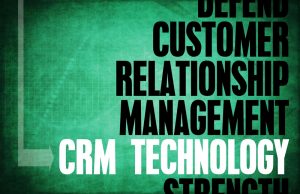Deciding to write a CRM RFP is a tough decision for most organizations. (Acronym Disambiguation: CRM = Customer Relationship Management; RFP = Request for Proposal).
Typical businesses decide to implement a new CRM solution, for the first time or to replace an existing solution, and go through a “selection process” that is loosely structured. Typically the process goes something like this:
- Browse the marketplace for possible CRM vendors.
- Select a “short list” of vendors to begin indepth demos and discussions with.
- Put together a list of “must have” and “nice to have” features based upon the features you’ve seen from vendors.
- Bring together a group of users and managers to compare the vendors against your must and nice to haves.
- Make the selection and plan the implementation based upon the vendors available services and recommended processes.
Of course, this approach is upside down. The primary risks that this approach leads to are:
- Lack of executive and staff buy-in, leading to poor adoption.
- Misfit of features to real business needs.
- Inefficient implementation and under-utilized solution due to poorly planned implementation and lack of resources.
Writing a CRM RFP inverts the order of the process and provides a framework for managing the selection and implementation process to ensure the best fit CRM solution is chosen and the implementation leads to a well used solution and maximum business value.
It’s a big job but, well worth the investment. Consider this: Even today, 50% of CRM Implementations fail to meet management expectations. What is the cost of CRM failure for your business?
How to Write a CRM RFP
Build a Selection Committee
Identify representatives of each group that will use the solution and just as importantly, be sure to include at  least one or two executives with the influence to ensure processes are followed and staff requirements are enforced.
least one or two executives with the influence to ensure processes are followed and staff requirements are enforced.
Business Process Documentation
List business processes from the standpoint of the customer’s experience and map out how your staff will use the CRM to manage that process.
Business Analytics Design
What reports and analytics will be needed by executives, marketing and end users? How will those reports be used to make decisions?
List and Prioritize Required Capabilities and Features
Each team and every user will have their own list of important CRM features. Add them all to a list. Be inclusive. This is a key part of making sure each group is on-board when it comes time to use the CRM system. Invite outside of the box thinking! Include features that might not be considered typical CRM features like marketing automation, integration with accounting systems or ERPs, etc. As an example, here’s are several lists of CRM Requirements provided to us by various clients.
Obviously, this list of “wants” is going to be long. So, of course, the 2nd step here is to prioritize. And this is where executive involvement is crucial. A handful of members of the committee that have a firm grasp of how the business really works, where profits come from and why customers choose your company over competitors should go through the entire  list of features you’ve built and assign a business value to them. This should not be an exhaustive process that involves lots of research or cost analysis. It’s soley for the purpose of prioritizing the requirements that will be the basis of your CRM RFP. Just put each feature in a “ballpark” in terms of the cost savings or additional revenue that should result. If it saves time, estimate the cost per hour and the number of hours.
list of features you’ve built and assign a business value to them. This should not be an exhaustive process that involves lots of research or cost analysis. It’s soley for the purpose of prioritizing the requirements that will be the basis of your CRM RFP. Just put each feature in a “ballpark” in terms of the cost savings or additional revenue that should result. If it saves time, estimate the cost per hour and the number of hours.
Again, don’t agonize over the math here. You’ll quickly realize that there are a short list of requirements that should deliver the lion’s share of the business value and the rest of minor contributors. As your CRM selection and implementation project unfolds, some in the organization may reach a point of fatigue or just get distracted. Keeping your eyes on the expected overall value to your business will help keep the team focused and motivated.
Write Your CRM Requirements
Reorganize the list into Must Have CRM features and Nice to Have CRM features. The Nice to Have list might need to be organized into 2 or 3 groups based on needs of particular groups, etc. Share this prioritized list of CRM requirements, with the associated estimates of derived business value, with the entire team for feedback. Be sure that executive management is on-board with your estimates and will support decisions that may leave “nice to have” CRM features out for constiuencies that report to them, so long as the Must Haves are achieved by the chosen CRM solution.
Plan the CRM Implementation
Take a look at the resources available to help with implementing the CRM solution including sales and marketing staff, IT staff, executives and consultants you’re already working with. What is their primary function? How much of their time can you afford to devote to the CRM implementation and for how long? Take a look at our “Ideal CRM Implementation Plan” for a more indepth look at what works.
No matter your industry or the CRM system you choose, there are a few crucial steps that will be required for someone to invest time in:
- Field design – what specific data elements will be captured in the CRM? What are the possible “answers” or valid input in these fields?
- Data mapping and loading – mapping the customer information you have (accounting software, sales people’s contacts, marketing lists, etc.) to the newly designed fields in your CRM solution.
- Process Documentation and Set Up – each CRM user role should be defined clearly in terms of what that user is required to input into the CRM system, when and how, framed by your Business Processes defined earlier on.
- Analytics and Report Design and Setup – customizing the chosen CRM solution to provide the needed metrics and reports.
- Template Design and Setup – email templates, proposal templates, customer service response templates, etc.
Really Write the CRM RFP
- List the Business Processes to be managed by the CRM system.
- List the Must Have CRM requirements and clearly mark them as such.
- List the Nice to Have requirements and provide some ranking of importance based on your business value analysis. It’s a good idea to provide your own table of features and requirements that vendors can answer yes or no to, line by line, so that you can easily take all the RFP responses and compare side by side.
- Define Expected Deliverables – Will your team load data and set up fields, reports, dashboards, templates, processes, integrations, etc.? Or will you require the vendor to do some or all of this? Clearly define which parts you plan to manage internally and which you need the vendor to handle.
- Described the Desired “Acceptance Testing” – Clearly, there are a lot of variable in a CRM implementation project and your vendor’s definition of “ready” and yours will not be the same. Consider planning a small “beta test” of the solution once its set up and ready to use. A small group of users can quickly try the primary business processes in the CRM and find oustanding issue quickly. This avoids disrupting the entire team and creating a negative impression when the system isn’t quite ready for prime time.

- Describe the Planned Training – Is there a national sales meeting planned where you’re expecting to train the team on the new CRM? Will there need to be separate training programs for various types of users?
- Describe Documentation Required – One of the great benefits of going through the process to write a CRM RFP is that key business processes often get defined and clearly documented for the first time. Do you expect the vendor to provide documentation of your specific business processes or will your team do that?